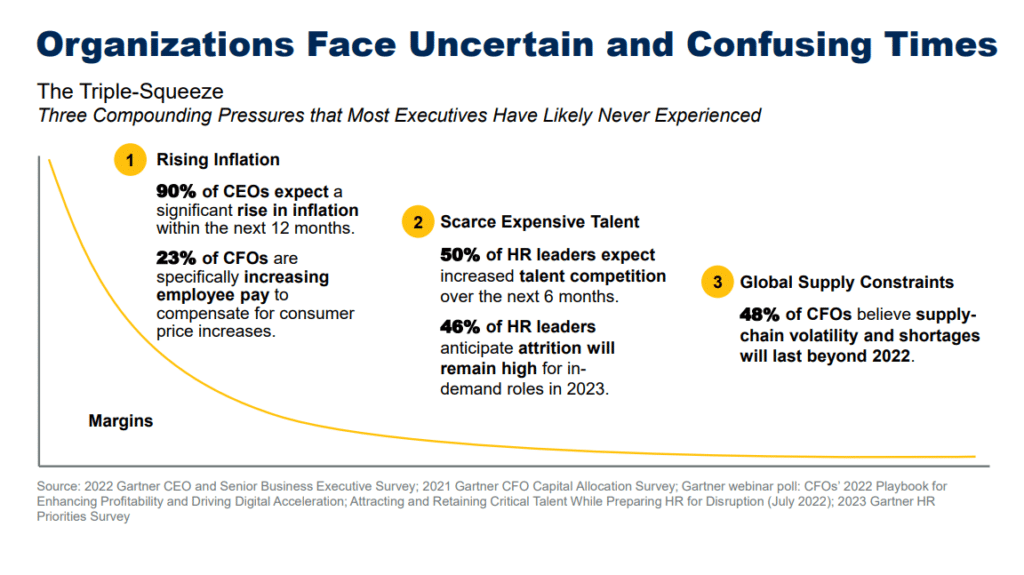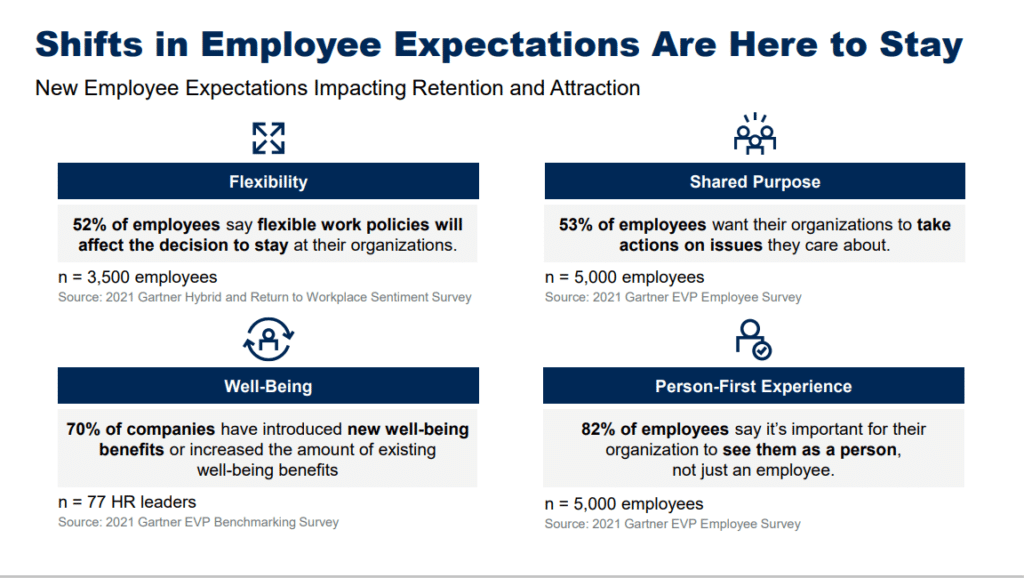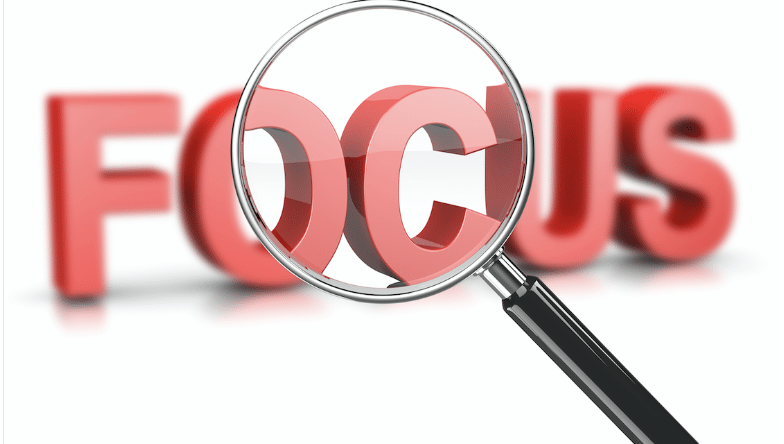The year 2023 will be the third year of economic, workforce, and organizational uncertainty due to three main factors. The first is rising inflation and how the US Federal Reserve Bank will respond by raising interest rates to halt inflation. Second is the scarce and increasingly expensive talent market will want more purpose-first experiences, well-being, and flexibility. Lastly (although diminishing), global supply chain constraints and shortages will lead to new value chain models and agility.
In the chart below, you can see the findings of Gartner surveys, including the 2022 Gartner CEO and Senior Business Executive Survey.

When looking at the organization from the bottom up, we look at the view from the employees’ perspective. However, executives see different priorities. Based on Gartner’s 2021 Gartner EVP Employee Survey and EVP Benchmark Survey of HR Leaders, employees prioritize a person-first experience, well-being, shared purpose, and workplace flexibility.
Please see Gartner’s chart below regarding the shift in employee expectations that are here to stay.

From our vantage point at MeBeBot, we see five areas of focus for HR in another year of economic, workforce, and organizational uncertainty.
No. 1 – Think Strategically.
HR executives need to be critical strategic thinkers for their organizations. Depending on the industry, workforce and supply chain costs are usually the highest costs in organizations. And the motivation of the workforce to achieve the organization’s strategies and goals is primarily determined by the organization’s culture. If it is transparent and thriving employees will be high contributors. If the culture is hostile, the employee effort employees will be mediocre, and turnover will soar.
Thinking strategically means shifting to a role that understands how the business makes money, the human capital requirements to achieve growth strategies and the tradeoff between alternative human capital strategies. For example, to improve employee wellness and motivation, is it better to improve the wellness program or expand hybrid working? Both give employees more control over the workday, which improves their sense of wellness and increases employee productivity.
Strategic HR executives do less overseeing of administration and spend more time with executives looking externally, down the road for the early signs of threats and opportunities to the business and sorting through alternative strategies. HR executives need to be dependable experts on HR research and talent management–and a coach to executives.
Finally, these HR executives create HR operating metrics to track the success of HR functions and workflows.
No. 2 – Continue Attracting and Retaining Talent.
Although many economists expect Federal Reserve Monetary policy will continue to raise interest rates and unemployment, the rise in unemployment from today’s 3.5 percent to around 4.5 or 5 percent will not create an abundant workforce. In the early days of Covid, 13 percent unemployment created an ample workforce supply. Today, the US workforce remains in a decades-long workforce shortage, and three million members of the workforce dropped out since the beginning of Covid-19.
While adjusting for 2023 budget changes, some restructuring of HR departments may be necessary. HR organizations will need to continue to do the following:
- Continue recruiting for needed talent to achieve revenue and strategic growth goals.
- Strongly work to improve retention. This will mean paying competitively to retain workers, providing the benefits today’s workforce wants, and reskilling your current talent. There is ample evidence that reskilling your workforce is cheaper than recruiting new employees to replace those who quit. Organizations get a high financial return from retrained, motivated, and grateful employees.
- How you do it is as important as what you do. Remember, employees today want to be seen as individuals, not as numbers. They want experiences that feel explicitly dedicated to them.
Forget all the nonsense of Quiet Quitting and Quiet Hiring. Be transparent with employees and improve your organizational culture. More on that later.
No. 3 – Make nice with hybrid work.
Long before Covid-19, remote and hybrid work were the No. 1 non-pay benefit was remote work. Today, employee surveys (in addition to Gartner’s EVP Employee Survey above) show that about 70% of office employees currently working remotely or in hybrid models want to continue to do so. According to the survey, 30 to 52 percent say they will look for other jobs if they are required to spend more days or five days a week in the office. With a decade-long labor shortage forecasted, you cannot afford these odds.
No. 4 – Improve your organizational culture
Earlier this year, MIT researchers uncovered that toxic organizational cultures drive employee turnover ten times more than pay. They found that your corporate culture may be the No. 1 cause of costly employee turnover.
The MIT researchers found that much of the media discussion about the Great Resignation has focused on employee dissatisfaction with wages. However, how frequently and positively employees mentioned compensation, however, ranks 16th in terms of predicting employee turnover.
A toxic corporate culture is by far the strongest predictor of industry-adjusted attrition and is ten times more important than compensation in predicting turnover.
The MIT researchers found that the leading elements contributing to toxic cultures include the eight items below. Three of these items will make most companies’ list of low-hanging fruit to improve culture and workforce performance. They are helping workers feel more respected, not demanding too many hours, and recognizing performance.
No. 5 – Invest in workforce technology during an uncertain economy.
According to a recent article in HR Executive, CHROs state the investment needed is all about HR data: collecting data, analyzing it, and quickly acting. Kathy Cullen-Cote, Chief People Officer of Teradata, says
“I believe data is a critical component in mitigating talent loss. Companies must leverage data to understand who is leaving their organization, and why. It is equally important to understand the same of those who have stayed. All too often, organizations wait too long to understand the experiences of their people. Regular employee pulse surveys will give companies useful insights into how their people are doing, enabling agile decision-making on the matters that are most important.”
MeBeBot’s AI-driven workforce bot provides easy tools to pulse survey employees on a wide range of topics. It also provides dashboards by regions, countries, and employee groups. With MeBeBot’s dashboard and reports, up-to-the-minute information is dynamically analyzed, from pulse survey results to questions answered.
The more you know about your employees, the better you can react quickly to prevent issues before they arise or stay on top of how employees are reacting to various circumstances and changes.
With the costs of high employee turnover, companies cannot afford not to have digital tools that enable access to these valuable insights.
*Read our blog on the impact of People Analytics Data to drive business outcomes

ABOUT AUTHOR
Bennett Sung
Working in HR / Work / and Recruiting Tech for 17+ years, Bennett collaborates with leading solution providers (including ADP/VirtualEdge, Bullhorn/Jobscience, Koru/Cappfinity, AllyO/HireVue, Humanly, and now MeBeBot) on their brand strategy, branding activation and demand generations.
